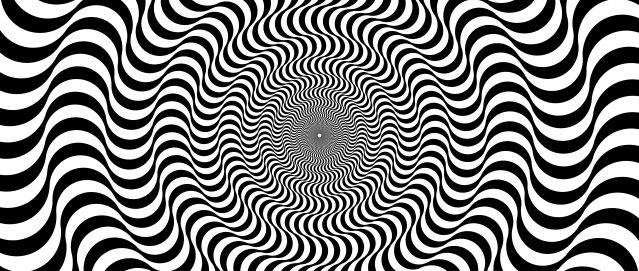Consciousness
The Predictive Brain and the 'Hard Problem' of Consciousness
Predictive processing theories are unlocking deep mysteries in neuroscience.
Updated November 28, 2023 Reviewed by Hara Estroff Marano
Key points
- Re-entry and predictive processing both focus on how top-down signaling shapes perception.
- Predictive processing theories are a broad framework that has revolutionized our understanding of the brain.
- The hard problem of consciousness requires a multifaceted view and a multi-targeted approach.

In this post, the last of a five-part series, we will acquire an understanding of various theories that emphasize the importance of top-down signaling in shaping and enabling conscious perception. First, we will discuss re-entry theories, a particular type of theory of consciousness that has several versions. Then we will discuss predictive processing theories, which are a more general approach to understanding how the brain works—an approach that has revolutionized neuroscience in the last couple of decades and which can inform theories of consciousness. Later, we will consider whether theories of consciousness overall are any closer to solving the “hard problem” of consciousness—how and why we have subjective experience at all.
Re-entry/Recurrent Processing Theories
Re-entrant/recurrent processing occurs in sensory systems that are highly interconnected, with feed-forward and feedback connections. Feed-forward processing transmits signals from sensory input to higher cognitive processing centers (bottom-up). Feedback goes in the reverse direction (top-down). Many neural networks contain pathways that loop back (re-enter/recur), enabling feedback mechanisms. Re-entry theories, also often referred to as recurrent processing theories (though there are some differences between the two terms), associate conscious perception with top-down signaling in those feedback pathways. Re-entry theories are supported by neurophysiological evidence revealing the importance of top-down signaling for conscious perception—especially in the visual system.[1]
Lamme’s Recurrent Processing Theory (RPT)
One prominent kind of re-entry theory is Victor Lamme’s version of recurrent processing theory (RPT), which was developed by focusing primarily on visual perception.[2] Like other re-entry theories, Lamme's theory posits that consciousness arises from feedback loops of recurrent processing in the brain. However, unlike other re-entry theories, Lamme argues that localized feedback processing within perceptual cortices (as opposed to long-range feedback loops) is sufficient to give rise to consciousness. By contrast, global neuronal workspace theory proposes that conscious access requires a more extensive architecture of reverberant loops, including frontal-parietal regions. Lamme suggests that consciousness can arise just from recurrent processes within local neural networks, even without involving the whole brain. He suggests that the parietal and frontal regions might be required mainly for post-conscious processing, such as planning or verbal reports.[3]
Predictive Processing (Predictive Coding) Theories
Predictive processing theories are a broader framework. They, too, emphasize the importance of top-down signaling in shaping and enabling conscious perception, but they are not so much theories of consciousness per se as a more general approach to understanding how the brain works. They are a powerful framework that can provide clues to the properties of consciousness.
While predictive processing theories represent something of a revolution in neuroscience in the last couple of decades, inverting the classical understanding of perception, the idea of the brain as a prediction machine dates back to the 19th-century German polymath Hermann von Helmholtz.[4] He proposed that the things we perceive are simply our brain’s best guesses as to what is causing its sensory inputs. Enclosed within the skull, the brain must infer what signals from the outside world represent by applying expectations, assumptions, or beliefs about the way the world is, basing these on its prior experience and learning.
In contrast, the classical view of perception is that sensory processing in the brain occurs in a bottom-up, outside-in manner, with the input starting at sensory receptors and moving to higher, more complex brain areas. Von Helmholtz's theory posits that sensory inputs mainly serve to correct or update the brain's top-down predictions rather than being the primary source of perceptual content. This view is often referred to today as predictive processing or predictive coding. In our technological age of predictive texting, the concept has become more intuitive to us.
Predictive coding models were first developed in the late 1990s. From the early 2000s onwards, Karl Friston extensively developed the theory and its mathematical foundations (particularly relating it to Bayesian brain theory[5]). The essence of predictive coding is that the brain continuously generates predictions about incoming sensory information and adjusts/updates these predictions (beliefs, you could say) based on the actual sensory input—constantly trying to reduce the prediction errors.
Some versions of predictive processing theory add the idea that the brain can minimize prediction error not just by updating its predictions but also by initiating actions to obtain expected sensory data. This is called active inference. It enables a form of predictive control.
Examples of influential theories that incorporate predictive processing include Friston’s free energy principle,[6] Stephen Grossberg’s adaptive resonance theory (ART),[7] Lisa Feldman Barrett’s theory of constructed emotion,[8] and Anil Seth’s “beast machine" theory.[9]
Bugs and Quirks
While most of the time the brain’s predictions are accurate guesses, the cost of efficiency is that the system jumps to conclusions based on partial information and is sometimes wrong. I have previously touched on how expectations (predictions) not only shape the brain’s most successful features but also may cause or contribute to problematic ones via the faulty top-down influence of expectation on perception. These problematic bugs and quirks include illusions, weird beliefs, anxiety, depression, chronic pain, chronic fatigue, psychosomatic problems, placebo effects (also contributing to the appeal of alternative medicine), and a whole lot more.[10] We humans are very suggestible (with some interindividual variability).
The Hard Problem of Consciousness
In this five-part series, we have examined the current leading theories of consciousness.
Is the field any closer to solving the “hard problem” of consciousness—the mystery of subjective experience: why it feels like something to be conscious, and how this could arise from purely physical processes? Not all theorists believe there is such a problem, arguing that the question may have been misframed and needlessly mystified, beginning with many mistaken assumptions [see footnote 11]. Regardless, it would be unrealistic for us to expect it to have been completely solved at this early stage in the still-young science of consciousness.
Of the four sets of theories we focused on in this series (following the selection of theories in Seth and Bayne’s 2022 paper, itself influenced in part by other reviews), only integrated information theory (IIT) explicitly aimed to solve the hard problem, and, in the view of its critics, it was flawed by being too ambitious. Higher-order theories of consciousness (HOTs), global workspace theory (GWT), and recurrent processing theory (RPT) addressed it more implicitly or indirectly. Attention schema theory (AST, which is not one of the four, but was mentioned earlier in this series) also tried a more direct approach, building on GWT.
Hohwy and Seth propose an indirect approach rather than trying to solve the hard problem of consciousness head-on. They argue that “consciousness” is not a singular explanatory target. Instead, conscious phenomenology's multifaceted structure provides a repertoire of explanatory targets. Systematically applying the powerful predictive processing framework to these targets could be more successful in addressing and potentially even dissolving the hard problem.[12]
What’s Missing?
Factors that I think receive insufficient focus by the four leading theories of consciousness are the three categories listed in Seth and Bayne’s paper[13] as “other approaches” (I called these “other strong contenders” in Part 1)
- Attention
- Learning
- Affect
All three of these factors probably play central roles in consciousness.
In the more specific case of human consciousness, language is another important factor that is not a focus of the theories we have reviewed.[14]
In addition, in my view, the biggest shortcoming of all four leading theories of consciousness is their relative lack of an evolutionary perspective (a notable exception is Ledoux, quoted in Part 2, who has incorporated HOT into a broader evolutionary framework[15]). Two other theories that were not among the four leading theories identified by Seth and Bayne deserve to be highlighted for putting the evolutionary framework front and center: Ginsburg and Jablonka’s unlimited associative learning theory (mentioned by Seth and Bayne under other approaches: learning) and a theory that did not make it into that paper but was mentioned by me in Part 1 and described in a previous post: Feinberg and Mallatt’s theory, which they call neurobiological naturalism (NN). UAL and NN are in broad agreement with one another.[16] UAL also incorporates predictive processing.
Subjective Experience
It’s worth noting that subjectivity is built into the very nature of life: as soon as the first cell evolved there was an inside and an outside, and therefore the beginnings of a subjective-objective divide between the body and the outside world. There is no physicalist-materialist principle that says you can’t have a divide between the interior and exterior world, with the interior being inaccessible to the exterior. There’s no need for mystery or mysticism in trying to understand this divide and why the interior of an animal’s experience is inaccessible to an objective observer.
The Enigma of Life
We would do well to remember the strong parallels between the mystery of consciousness and the apparent enigma of life itself, which was originally believed to surely possess some sort of nonphysical animating essence absent in ordinary matter. Both life and consciousness are complex, emergent phenomena, requiring systems theory to understand them.[17] The mystery of life eventually dissolved as science employed a gradual, systematic approach to life's multifaceted elements, understanding the fully natural self-organizing complexity of its purely physical processes.
References
1. Seth, A. K., & Bayne, T. (2022). Theories of consciousness. Nature reviews. Neuroscience, 23(7), 439–452. https://doi.org/10.1038/s41583-022-00587-4.
2. Lamme V. A. (2006). Towards a true neural stance on consciousness. Trends in cognitive sciences, 10(11), 494–501. https://doi.org/10.1016/j.tics.2006.09.001; Lamme V. A. (2010). How neuroscience will change our view on consciousness. Cognitive neuroscience, 1(3), 204–220. https://doi.org/10.1080/17588921003731586.
3. As evidence, Lamme cites experiments in which stimuli such as letters were briefly presented to subjects, who reported seeing more letters than they could identify in their report. However, there are methodological challenges in testing for the presence of phenomenal consciousness independently of access / report.
4. Clark A. (2013). Whatever next? Predictive brains, situated agents, and the future of cognitive science. The Behavioral and brain sciences, 36(3), 181–204. https://doi.org/10.1017/S0140525X12000477.
5. The Bayesian Brain theory suggests that the brain operates like a statistician, constantly making and updating predictions about the world based on past experiences and new sensory information, to form perceptions and guide decisions.
6. Karl Friston’s Free Energy Principle (FEP) posits that biological systems minimize a quantity referred to as "free energy" to maintain homeostasis and adapt to their environment. According to FEP, the brain actively works to decrease surprise or uncertainty (the term free energy is can be thought of as synonymous with surprise). The brain achieves this by generating predictions through internal models of the world, which are updated based on sensory input, always trying to align its internal model with the external environment and improve the accuracy of its predictions—minimizing prediction error or uncertainty. Organisms actively engage with their environment to bring their sensory inputs in line with predictions ("active inference").
7. According to Grossberg’s Adaptive Resonance Theory (ART), when an active expectation matches attended critical features well enough, a state of resonance occurs. The theory posits that resonance is the physical instantiation of subjective awareness, and therefore of consciousness.
8. Feldman Barrett’s “Theory of Constructed Emotion” is a theory on the nature and origin of emotion, centering on the role of prediction (more specifically active inference) as the brain tries to keep the body within its “budget,” maintaining a viable bodily state. The theory posits that emotions are predictions that the brain creates based on a combination of sensory input, past experiences, and contextual knowledge. Culture plays an important role in shaping these.
9. The primary claim of Seth’s “beast machine theory” is that consciousness is grounded in allostatic control-oriented predictive inference. "Allostatic" refers to the process by which the body achieves stability through physiological or behavioral change. Unlike homeostasis, which is about maintaining a constant internal environment, allostasis is more about the dynamic process of adaptation to both external and internal changes. See The Brain as a Prediction Machine: The Key to Consciousness? and The Brain as a Prediction Machine: The Key to the Self?
10. Andy Clark, The Experience Machine: How Our Minds Predict and Shape Reality (New York: Pantheon, 2023).
11. One of those mistaken assumptions is that thoughts are not physical. See What Actually Is a Thought? And How Is Information Physical? and Mind-Body Problem: How Consciousness Emerges from Matter. Furthermore, Michael Graziano, in his Attention Schema Theory, points out that the brain has no access to its own underlying neuronal workings, just a simplified, caricature-like self-description depicting an internal essence with a capacity for knowledge and experience, leading the brain to conclude that it has a nonphysical essence of awareness.
12. Hohwy, J., & Seth, A. (2020). Predictive processing as a systematic basis for identifying the neural correlates of consciousness. Philosophy and the Mind Sciences, 1(II). https://philosophymindscience.org/index.php/phimisci/article/view/8947.
13. Seth, A. K., & Bayne, T. (2022).
14. Daniel Dennett emphasizes the role of language in human consciousness—see my post Are We All Zombies? (Are Humans Truly Conscious?). For more discussion about how language emerges from, and in turn shapes, mental representations, see What Actually Is a Thought? And How Is Information Physical?, Mind-Body Problem: How Consciousness Emerges from Matter and In a Meaningless Universe, Where Does Meaning Come From?
15. Joseph E. LeDoux, The Deep History of Ourselves: The Four-Billion-Year Story of How We Got Conscious Brains (New York City: Viking, 2019), Joseph E. LeDoux, The Four Realms of Existence: A New Theory of Being Human (Cambridge, MA: Harvard University Press, 2023). LeDoux also incorporates predictive coding into his theory.
16. Ginsburg and Jablonka’s Unlimited Associative Learning theory (UAL) focuses on the evolution of a relatively more complex form of associative learning in animals around 500 million years ago, which they suggest marks the beginnings of primitive, minimal forms of consciousness.
17. Feinberg, T. E., & Mallatt, J. (2020). Phenomenal Consciousness and Emergence: Eliminating the Explanatory Gap. Frontiers in psychology, 11, 1041. https://doi.org/10.3389/fpsyg.2020.01041.




